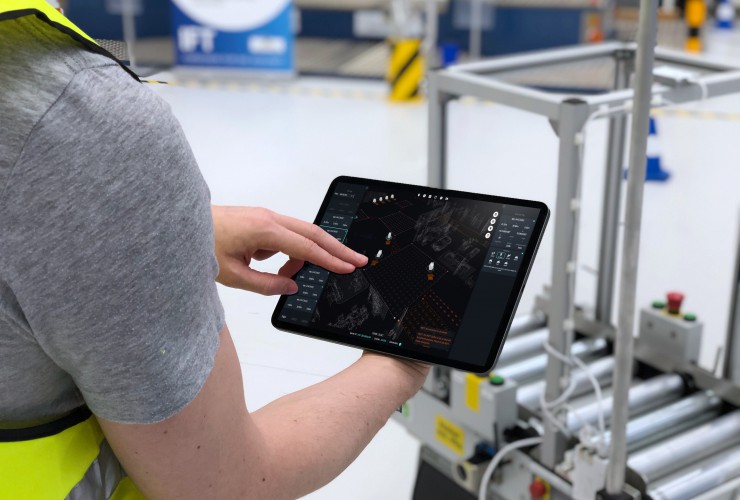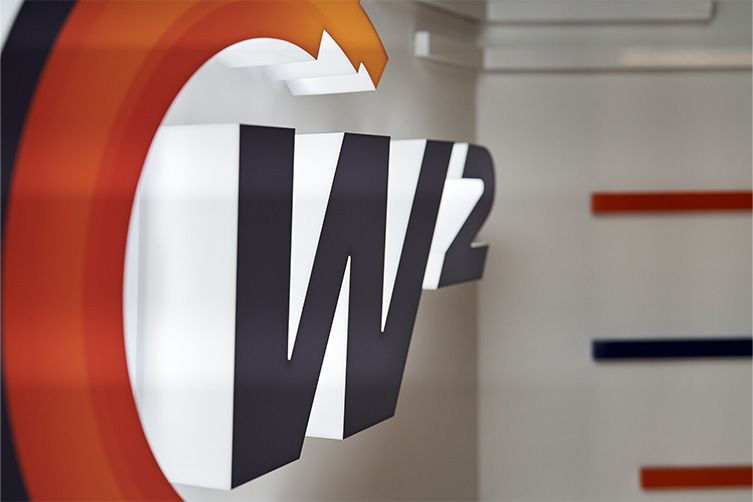On the day the IFOY Award winners are named at BMW World in Munich, we look at the last of the finalists – NAiSE TRAFFIC by NAiSE in the Start-up of the Year category.
IFOY category: Start-up of the Year
Description
The NAiSE solution is essentially a manufacturer-independent control system for AGVs/AMRs with the unique feature that the entire intralogistics mixed operation is included in both traffic control and order distribution. This is made possible by the NAiSE RTLS localization network, which was developed and patented in-house: Radio sensors in the hall infrastructure enable precise localization and simultaneous near-real-time communication of and between the traffic participants (people, forklifts, tugger trains, AGVs/AMRs), using ultra-wideband technology that enables robust and reliable localization even in difficult industrial environments. The transparency gained from this enables the central software to do much more than the essential guidance control of AGVs/AMRs: due to past localization data, traffic analyses can be carried out on a regular basis, making conflict zones recognizable to the user, e.g. by means of heat maps. The bottlenecks and traffic jams in the flow of goods resulting from the conflict zones can then be solved playfully in the software by creating traffic zones. For seamless integration into the environment, gates are also controlled and fire alarm systems are integrated. Through the generic order interface, the integrated order manager receives the transport orders and transmits them to the appropriate participants as configured by the operator.
Summary
NAiSE TRAFFIC is the world’s only traffic and order management software for all participants in intralogistics. An elementary feature is that through the patented localization network (NAiSE RTLS) the entire mixed operation, consisting of people, forklifts, tugger trains and also AGVs/AMRs, is included in the traffic control and thus a more efficient and safer material flow in the warehouse and in production can be ensured.
CLICK HERE to watch a video.
IFOY TEST REPORT
NAiSE Traffic is the world’s only software for traffic and order management that includes all participants in the intralogistics process. The patented Real-Time Localisation System (RTLS) network includes all “traffic participants” in the traffic control and thus ensures the safe, efficient flow of materials in logistics and production.
To demonstrate its software, NAiSE is switching live from the test hall in Dortmund to the future factory “Arena 2036” at the Stuttgart headquarters. MAiSE will clearly demonstrate the functionality, added value and philosophy of its manufacturer-independent control system for industrial transport robots in material flow using diagrams, dashboards and heat maps. In contrast to VDA 5050, which is currently very popular and makes life easier for master controllers in particular, NAiSE follows a completely different way of thinking when it comes to traffic control. The Stuttgart-based company also integrates non-robots: people, forklifts, the pallet trucks – regardless of whether they are VDA-5050-compliant or not. NAiSE emphasises that it does not want to draw a line under VDA 5050, because the hybrid state, i.e. humans and robots, will still exist in warehouses and production for a long time to come. In addition, they do not want to take away the manufacturers’ intellectual property (IP), as they put it, that is their USP. At the manufacturer Omron, for example, this is the high degree of autonomy of the robots.
Despite all the really well-designed screen displays, NAiSE cannot do without “grounding”. In the perhaps 50 square metre test field we enter, there are three areas: In one, an AMR from Omron drives around, then there is an encounter zone, and in a third area, a VDA-5050-compliant transport robot, which is not specified in more detail at first glance, acts. And to make matters worse, a colleague with his sack truck keeps getting on my nerves, venturing into the area frequented by several participants for demonstration purposes. The tester also gets mixed in.
But how exactly does the guidance system work? In the self-developed, patented localisation network NAiSE RTLS, radio sensors in the hall infrastructure enable precise localisation and near-real-time communication of and between the traffic participants. Ultra-wideband technology (UWB) is used here, with the help of which objects can be located robustly and reliably even in difficult industrial environments.
The highlight of this is that regular traffic analyses can be carried out using localisation data from the past, which, for example, show conflict zones on the basis of heat maps. One can then resolve the bottlenecks and congestion in the flow of goods resulting from the conflict areas almost playfully by creating traffic zones. For seamless integration into the environment, gates are also controlled and fire alarm systems are integrated. Through the generic order interface, the integrated order manager receives the transport orders and transmits them to the appropriate participants as configured by the operator.
NAiSE also already has something to show: At Continental in Ingolstadt, for example, the material flow could be increased by 30 per cent, according to the company. But the system is also in productive use in China, in Germany still in Schwenningen am Neckar and at the automotive supplier Vitesco in Rheinböllen, a division of Continental.
IFOY Test Verdict
NAiSE Traffic is not only interesting because of the integration of really all potential “participants” in the warehouse, i.e. not only AGV or AMR, but also people and hand pallet trucks in mixed operations: the traffic and order management software also shines with the USP that it iteratively supports the person responsible for operations in adapting the material flow to the ever-changing circumstances. In the software tool, a bird’s eye view of the processes can be taken at any time and problem areas can be identified at an early stage with the help of analysis options.
IFOY INNOVATION CHECK
Market relevance: The NAiSE TRAFFIC software handles traffic and order management for various conveyor systems in intralogistics. Especially against the background of VDA 5050, the use of different vehicle systems at one location is on the rise. The software claims to be able to control the joint use of traffic areas by employees, industrial trucks with drivers, driverless transport vehicles and also autonomous mobile robots (AMR) within buildings, especially with localisation elements based on UWB technology. This task of traffic control is of outstanding importance for the efficient and safe realisation of transport processes for intralogistics, so that the market relevance of the solution is to be assessed as high
Customer benefit: The benefit for the user results from the possibility of being able to use different vehicle systems, whether manually guided or classically automated or autonomously controlled, on mixed-use routes. This makes it possible for the user to avoid conflicts in vehicle operation even with little effort. In particular, NAiSE TRAFFIC should be able to reliably prevent unsolvable mutual obstructions, so-called blockages, at intersections and at pick-up or drop-off points. NAiSE TRAFFIC cannot be used to further optimise the use of routes, as the respective decisions regarding the movements of the individual road users only become visible to the software through localisation.
Novelty: The consistent independence from individual providers is attractive, but is already offered by other software providers. In combination with the own UWB localisation system, however, a degree of novelty is achieved, as any vehicles and persons can be localised, provided they are each equipped with a UWB device.
Functionality / type of implementation: The functionality could be well understood on the simple test setup. The updating of the localised road users appears to be quite fast. Nevertheless, it has to be evaluated that the functionality is only given if all participants are equipped with a UWB localisation device and that this requirement can be safely realised in the daily operational routine. Compared to conventional software solutions for traffic and order management, the graphical user interface with the layout representations based on point clouds is solved differently. For regular users, however, this implementation does not appear to be suitable for ergonomic reasons, as intuitive orientation is not easy.
Verdict: Even against the background of VDA 5050, both the market relevance and the customer benefit are to be rated as high. The technologies used and the associated innovation, together with the implementation, can be described as good.
market relevance ++
customer benefit +
novelty +
functionality / type of implementation Ø
[++ very good / + good / Ø balanced / – less / – – not available]
For an overview of all the finalists, visit www.ifoy.org
CLICK HERE to find out more about NAiSE TRAFFIC – the world’s only traffic and order management software.





 The average price-per-mile for haulage and courier vehicles has jumped from 103.1 points in June 2019 to 122.0 points in June 2022, according to the TEG Price Index – a rise of 18% over the three-year period.
The average price-per-mile for haulage and courier vehicles has jumped from 103.1 points in June 2019 to 122.0 points in June 2022, according to the TEG Price Index – a rise of 18% over the three-year period.





